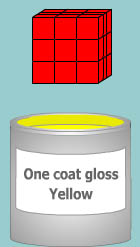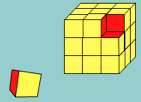Painted Cube

 Imagine a large cube made up from 27 small red cubes each measuring 1 cm by 1 cm by 1 cm. What is its volume?
Imagine a large cube made up from 27 small red cubes each measuring 1 cm by 1 cm by 1 cm. What is its volume?
Imagine dipping the large cube into a pot of yellow paint so the whole outer surface is covered. What is its surface area?
Now imagine breaking the cube up into 27 small cubes.
How many of the small cubes will have yellow paint on their faces?
Will they all look the same?
How many red faces and how many yellow faces do they have?
Now imagine doing the same with other big cubes made up from small red cubes.
What can you say about the number of small cubes with yellow paint on?
What interesting discoveries can you make?
Click here for Notes for Teachers.
This problem is adapted from the NRICH task Painted Cube with permission of the University of Cambridge. All rights reserved. Click here to download the NRICH poster.
22 Responses to Painted Cube
Leave a Reply Cancel reply
You must be logged in to post a comment.
South Africa COVID-19 News
Here is the official website for COVID-19 updates.
Login
SUPPORT AIMSSEC






I think it will be easy for the learners to find the information that is needed because they are doing it in a practical way by themselves.The lesson was very interesting,Ill take it to my learners.
This is an interesting exercise this can be used to reinforce the terminology of 3D shapes like vertices, edges and faces. I can use cubes from the foundation phase to do it practically.Patterns can be observed here.
This can be a good exercise even for grade 8 learners when doing a session on 3-D shapes even when calculating surface area of cubes.Learners will calculate practically the surface area.
The cube and the dipping of the cubes in another paint was very very interesting, learners can enjoy the exercise and draw their own conclusions. The only snag can availability of material. I just thought quickly that a saw and scrap wood can be used to create the small squares or buy some,
This is a practical and nice activity for group discussion.
Hi Cynthia
This was an a challenging activity but very interesting. I think the same will apply to my learners. This also proves that teaching and learning of maths can be more fun.
Regards
Ntosh
This is very interesting and it will me in teaching my learners ,its practical as our learner likes playing.To other teachers the way of approaching 3D objects it was not easy but now I it will be easy
Its very good exercise especial for grade7 learners when you want to teach about faces,edges,and vertices .Its more practical.
it was an interesting exercise, very practical and I am sure that learners will master the 3D shape terminology
In this section I have gain most of things that I have never noticed before .In this exercise I WAS ABLE to learn more on number of faces in different cubes and as 3D SHAPE IS THE MOST DIFFICULT thing to me but I think now I will be able to teach my learners what I have learn.
It’s an interesting activity,it’s thought-provoking & i think my learners are going to enjoy it & any misconceptions which may occur when presenting without this activity ,will be cleared!
It is very interesting to here.This exercise is a good example to teach 3D shapes,patterns,square and cubic numbers etc.Hopefully i’ll also use concrete objects like these in my classes with my learners.
Thank you.
This lesson is very interesting to me ,I also gaining a lot .I will take this lesson to my learners .I notice that as you increase the cubes the vertices ,edges ,faces also increase in numbers. I get to the conclusion of finding the formula for this problem .
This was an interesting activity based on lo 3 and lo 4 ( space and shape as well as measurement) and I believe learners will enjoy it because it teaches a lot of concepts and terminology at the same. I would teach it in grade 07 to consolidate what the learners learnt in the intermediate a phase and introduce them to calculation of volume in the senior phase.
Learners will be able to relate faces, edges, vertices to the number of yellow and red faces in each tube. The activity also introduces them to formulae which will help them to predict the number of each colour painted cube.They will now use formulae in the senior phase to work out certain quantities.
It is so interesting the way the 3D shapes are being made clear through practical work. Here the learners learn by doing on their own. the more they play with the cubes the more discovery they will be doing. With the necessary resources maths can be made easy. Learners are able to calculate the number of cubes, faces, edges and vertices. Oh! with AIMSSEC maths can be made simply that`s what I appreciate most.
The lesson is interesting as it will make learners to be more creative and able to discover the faces,edges and vertices for themselves.I can also use the cubes to teach the patterns.
This is amazing. I like it. My learners will be more interested in 3-dimensional objects if I can use this method when teaching them. Building up the cubes themselves, counting the faces in a more practical way will activate the interest of wanting to know more. I like that this starts very simple gradual coming to more complex when deriving the formula for number of edges and faces of painted cubes. Thanks Cynthia, I WILL TRY THIS WITH MY LEARNERS.
Its so interesting to my Grade 07 learners.I hope they will enjoy it when Im introducing 3D shapes because its too practical.
This is really challenging. It needs focus.It is really interesting, it needs time.
Learners can establish formulas on their own and they can remember this easily as they have done it themselves.
This is rather challenging but we managed to find that there a relationship between the no. of edges and the number of the dotted cube but it was not easy for us to find the general rule but we would love to get more time to find it so that we can take it to the learners confidently.
at the beginning it was not easy to find the number of yellow ones. The learners can be able to identify edges, vertices and faces,and find cubic numbers.
it was challenging but later i got it whaw